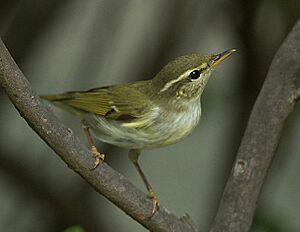Arctic warbler facts for kids
Quick facts for kids Arctic warbler |
|
|---|---|
 |
|
| Taipei | |
| Conservation status | |
| Scientific classification | |
| Genus: |
Phylloscopus
|
| Species: |
borealis
|
 |
|
| Distribution of Arctic warbler Breeding Non-breeding | |
The Arctic Warbler (Phylloscopus borealis) is a small bird found in many parts of the world. It lives in birch forests or mixed forests near water. You can find them breeding in places like Fennoscandia (parts of northern Europe) and across northern Asia. They have even started breeding in Alaska, North America!
These birds are amazing travelers. They fly very long distances! The entire population spends its winters in southeast Asia. This means the Arctic Warbler has one of the longest migrations of any insect-eating bird from the "Old World" (Europe, Asia, and Africa).
Contents
What is an Arctic Warbler?
The Arctic Warbler is a type of leaf warbler. These are small, active birds that often search for insects among leaves.
Appearance
Arctic Warblers look like typical leaf warblers. They are greyish-green on their backs and off-white underneath.
- Wing Bar: A single light bar on their wing helps tell them apart from most similar birds.
- Bill: They have a strong, dagger-like bill. The tip of their lower bill is dark.
- Size: They are a bit larger than some other similar warblers, like the Greenish Warbler.
What do they sound like?
The Arctic Warbler's song is a fast, buzzing trill. It's a sound you might hear echoing through the northern forests where they live.
Where do they live?
Arctic Warblers prefer forests with birch trees, especially near water. They build their nests on the ground, often hidden in a low shrub.
Their Diet
Like most Old World warblers, the Arctic Warbler loves to eat insects. They are always busy looking for bugs to munch on!
Amazing Journeys
These birds are famous for their incredible migrations. After breeding in the far north, they fly thousands of miles to warmer places in southeast Asia for the winter.
Visiting New Places
Sometimes, an Arctic Warbler might get a bit lost during its long journey. They occasionally show up in western Europe in the autumn. For example, they are seen almost every year in Great Britain. Between 1958 and 2001, there were 225 confirmed sightings of Arctic Warblers in Britain!
Naming the Arctic Warbler
The scientific name for the Arctic Warbler is Phylloscopus borealis.
- Phylloscopus: This part of the name comes from ancient Greek words. Phullon means "leaf," and skopos means "seeker" or "watcher." So, it means "leaf-seeker," which fits how these birds look for food!
- borealis: This part comes from Latin and means "northern." This makes sense because they breed in northern parts of the world.



